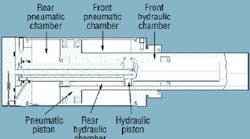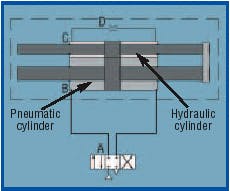The concept of hydropneumatic hybrid actuation is novel and has generated four basic patents registered with the US Patent Office. Though the concept is broad and covers linear as well as rotary actuation devices, the general principle of operation behind it can be explained with the aid of the two illustrations on the next page.
In concept, a of hydropneumatic actuator is constructed of a pneumatic cylinder and a self-contained hydraulic damping cylinder with its chambers connected through a fluid flow governor (fixed or variable orifice). This allows controlling displacement and position hydraulically. Depending on load dynamics and construction of the actuator, the degree of control ranges from simple damping of erratic motion to sophisticated motion control using first and second order derivatives of displacement.
The novelty of the hydropneumatic actuator is attributed to zero volumetric differential passive hydraulic damping. Zero volumetric differential simply means that the absolute value of the volumetric change of the front hydraulic chamber equals the absolute value of the volumetric change of the rear hydraulic chamber.
Referring to the illustration at right, the housing of the pneumatic and hydraulic cylinders are stationary. Their piston rods are connected through a mechanical link, so any motion of the pneumatic piston must be translated to an equal motion of the hydraulic damping cylinder's piston rod. The hydraulic cylinder's front and rear chambers are connected hydraulically through a flow governor, which is an orifice.
Routing compressed air into either port of the pneumatic cylinder moves its piston and, consequently, the hydraulic cylinder's piston. In turn, hydraulic fluid flows from one side of the hydraulic cylinder, through the governor, and into the other side of the hydraulic cylinder.
As the fluid flows through the flow governor, any accelerations or decelerations generated by the pneumatic cylinder are damped. Thus, hydraulic losses from the governor make the actuator's motion smooth and consistent.
Potential applications
Among the most obvious application fields is food processing machinery, where pneumatics already is used extensively. Other applications include more general industrial-machinery, such as presses, drill presses, special air-assist devices, forging machines, riveting machines, aircraft flight control systems because of the device's high energy efficiency and power density, construction equipment, machine tools, industrial robots and manipulators, automation systems, and others.
For more information on the hybrid actuator, contact the author at 425/787-5381, or e-mail [email protected].



